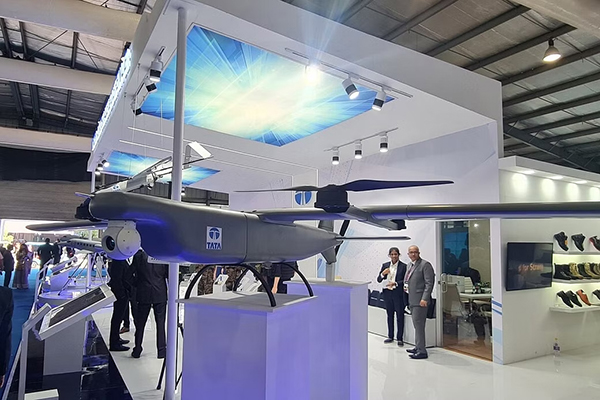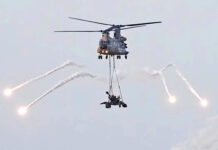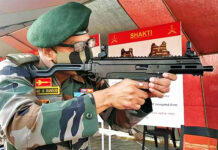At the time when the de-escalation of the massive forces deployment by Chinese PLA and Indian Army is yet to take place in the Eastern Ladakh, the Ministry of Defence (MoD) issued the fifth Request For Proposal (RFP) within a fortnight for procurement of drones, on 25 October, to add to the capabilities of Indian Army’s elite Special Forces along the Northern Border..
The current RfP is for 750 hi-tech precision strike drones, termed Remotely Piloted Aerial Vehicle (RPAV). The previous RFPs were issued to procure 1,000 Surveillance Copters and 80 Mini Remotely Piloted Aircraft (RPAs).
Hi-tech Precision Strike Drones
The MoD intends to procure 750 RPAVs for the Indian Army’s Parachute (Special Forces) Battalions which are mandated to execute special missions behind enemy lines through Fast Track Procedure under Emergency Procurement.
The Army’s special forces are looking for specialised drones that can provide 3D imagery of the terrain to launch operations.
The RFP is part of the tendering process seeking commercial and technical bids from suppliers. Some 750 such drones are needed. “The current volatile situation along the northern borders warrants expeditious procurement of operational equipment,” the RFP document said. The Army is looking for UAVs that can provide round-the-clock surveillance with ability to scan the target area and provide a processed 3D scanned image of the target to execute special missions. The MoD wants to keep out any Chinese parts and has asked the vendor to provide NATO stock number (NSN) for each item provided by a foreign maker.
This force multiplier would enable the Special Forces to execute pinpoint precision strikes during direct action tasks such as raids, elimination of high-value targets, and command and control elements including enemy leadership.
This equipment will be deployed for situational awareness and short-range surveillance that will enable the special forces to execute pin-point precision strikes during direct action tasks. The Army wants the UAV to be about 2 kg in weight and be operable by one person. The UAV needs to have an endurance of 30 minutes and be able to operate indoors and in GPS-denied areas.
Remotely Piloted Aircraft
On 20 October 2022, the Army began the process to procure 80 mini remotely piloted aircraft systems and 1,000 surveillance copters to bolster its overall surveillance apparatus along the Line of Actual Control (LAC) with China. Officials said the mini remotely piloted aircraft is an ideal multi-sensor system to carry out day and night surveillance and target detection in high-altitude regions.
The last date for submission of bids for the remotely piloted aircraft programme was November 16. “The system will be able to provide high resolution imagery to enable target detection, recognition, identification and accurate location of adversary’s location as well as build up of troops,” said an official.
The mini remotely piloted aircraft systems are being procured under the ‘buy’ (Indian) category. According to the request for proposal or initial tender, the select supplier will have to supply the platforms within 12 months of signing the contract.
As per the requirement of the Army, the new man-portable mini-RPAS must weigh up to 15 kilograms, have a mission range of at least 15 kilometers, and have an operation endurance of no less than 90 minutes. While the runway-independent RPAS should have the vertical take-off and landing (VTOL) capability at an altitude of 13,000 feet with a minimum four-hour endurance
The new RPAS will be used for tactical surveillance to locate enemy soldiers and weapon systems in a particular sector. In contrast, strategic surveillance aims to determine the big picture, for example, where the enemy is concentrating his forces, what routes are used for supplies, where are the logistics hubs, etc.
The new RPAS with day-and-night capability are consequently needed by forward observation posts to look deeper and direct, correct, and analyze artillery fire.
Surveillance Copters
The Army’s procurement of 1,000 surveillance copters through fast track procedure under emergency procurement process is also aimed at boosting surveillance along the frontier with China.
“For surveillance needs of the Indian Army, expeditious procurement of surveillance copters for meeting urgent operational requirements is an operational imperative, where undue/unforeseen delay is seen to be adversely impacting the capacity and preparedness of the Indian Army,” according to a brief on the programme.
It said the surveillance copter will provide aerial surveillance capability and sustained point surveillance to the Indian Army.
The last date for submission of bids for the programme is November 17.
A surveillance copter is an ideal multi-sensor system to carry out real-time reconnaissance and surveillance day and night. It will provide high-resolution imagery to enable target detection, recognition and accurate location of adversary’s build-up. The UAVs will be sourced from Indian companies.
The copters will provide aerial surveillance capability and sustained point surveillance to the Army. It will have a multi-sensor system to carry out real-time reconnaissance and surveillance of an area of interest.
The system will provide high-resolution imagery to enable target detection, recognition, identification and accurate location of adversary’s build-up, mortars, guns, movement of troops and vehicles during border management and active operations.
The copters will have an all-up weight of no more than 10 kg and can take off from an altitude of 13,000 ft.
Swarm Drone Systems
To enhance its defensive and offensive capabilities, the Indian Army in August 2022 inducted the swarm drone system. As evident from the recent ongoing conflicts globally, they have proved to be a major force multiplier. Even at the borders in India, drone-related incidents have seen a major surge in the past few months.
The resourcefulness of the swarm drone technology has proved itself during the recent conflicts in Armenia, Azerbaijan, Syria and the strike on oil fields in Saudi Arabia and the recent Russia-Ukraine war.
Loitering munitions, Aerial Targeting System
The Army has started the process to procure 120 loitering munitions and 10 aerial targeting systems to bolster its military might along the frontier with China.


The RfP for the procurement was issued around November 14. The loitering munitions and the aerial targeting systems are being procured under the fast track procedure within the framework of ‘buy Indian’ category, they said.
Under the prescribed specifications, the aerial targeting systems will be required to have a range of 100 km.
Separate Cadre of UAV Operators
The Army is looking to create a separate cadre for operating its Unmanned Aerial Vehicles (UAVs), according to Lt Gen AK Suri, Director General of Army Aviation. He was speaking at a seminar on Unmanned Aerial Systems, organised by Indian Military Review, on 16 September 2022.
“This cadre will be of operators in terms of piloting and will reduce the load on helicopter pilots,” he said, adding that Indian Army has been using UAVs for the last two decades, he said they have primarily used them in the northern and western borders. A major part of the surveillance is carried out by them.
The proposal is currently with the Army headquarters and once cleared, will be sent to the Defence Ministry for approval. A similar proposal for a separate UAV cadre by the IAF has been long pending with the Defence Ministry for approval.
Speaking at the seminar, Air Marshal Radhakrishnan Radhish, Senior Air Staff Officer (SASO) at Western Air Command, said the IAF has a road map for induction of more capable medium-altitude long-endurance UAVs as well as high-altitude long-endurance UAVs. IAF is joining an indigenous effort to develop a UCAV and Aeronautical Development Establishment (ADE) has been sanctioned to develop the niche technologies, he stated. Awareness of the enemy (battlefield transparency) is crucial in high altitude where mobility is a prime factor in gaining advantage and these will help the Units deployed in the Northern Borders. These RPAs will assist the local commanders in gaining information on the enemy position, men and equipment and about the changes on ground, thus enabling them to take timely and appropriate action,” he said.



















